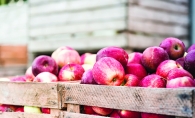After a full 2016 season and January off, Chateau St. Croix has reopened under new management with regular hours and events that celebrate local wine, art, cheeses and gourmet foods. Nestled in rolling hills north of St. Croix Falls, Wis., its expansive property includes a vineyard, carriage house, formal garden with a fountain and statuary, a tasting room modeled after a French chateau, and a huge patio with an amazing view. At the heart of it all is a commitment to growing and sourcing the best grapes to create top-quality wines.
“This is really an agriculture business. The fruit comes in quickly—in the span of about three to four weeks in fall, and then it’s crunch time,” general manager and winemaker Matthew Scott says. That’s when he and his team pick and process their grapes and see how next year’s product is shaping up. He notes that while Midwestern grape-growing is experiencing a bit of a resurgence right now, it’s nothing new.
In the late 1800s, Missouri was the nation’s top wine-maker by volume, he says. Even Minnetonka, Minn., was home to a huge vineyard and winery. “The Midwest’s whole beer- and wine-making industry was set back by Prohibition,” Scott says. “Now we’re just starting to get back to our roots. Millennials drink more wine than Boomers, which helps the industry. Restaurants are also big on the ‘local’ movement, pairing wines with interesting foods.”
Scott says the demand for wines—especially local ones—has helped speed up Midwestern grape-growing. Monocultural crops—those with just one variety of plant—can be more susceptible to blights and diseases, like the one that caused the Irish potato famine. So the demand also has driven an urgency to develop new cold-hardy varieties that will expand the grape-growing region and add biodiversity to grape crops.
The University of Minnesota has gained a reputation for being on the cutting edge, developing the cold-hardy Itasca and Frontenac grapes, among others. Its Marquette has become Chateau’s “flagship red,” front and center in all but the house cabernet. For Chateau’s 2016 releases, about 65 percent of the grapes were grown locally, mostly in the St. Croix River Valley.
“Minnesota is on the 45th parallel—that’s the same as Bordeaux [in France], except they have the ocean keeping temperatures constant, and we have the polar jet stream pushing cold air down on us. So we have to protect our grapes in winter,” Scott says. Of 6,000 commercially grown varieties of grapes, “people only know [about] 12,” he says. But Chateau and other small growers are hoping to change that lack of education by producing delicious wines that are more diverse.
So far it’s working. Of several award-winning Chateau wines, Wisconsin White is the most decorated, winning double gold at the Indy International Wine Competition and gold at the San Francisco International Wine Competition. As a certified sommelier, Scott leads Chateau’s day-to-day growing and production, but keeps an eye on the big picture of the wine industry. He hopes that Chateau will continue to add depth to the growing regional wine scene. “Things have changed so much over time,” he says. “It’s fun to see that happen. And every year, the quality of Midwest wines goes up, up, up.”
St. Patrick’s Day at the Chateau
March 16–19
Bust out the green clothes and shamrocks. Each year, the Chateau St. Croix team picks a favorite white wine to dye green and serve tasting-style or by the glass in honor of St. Patrick’s Day. “It’s the perfect weekend to get out, forget about winter and start thinking about spring,” says sommelier Matthew Scott. Enjoy live music and—if it’s nice out—views of the gorgeous countryside. The event kicks off a full line-up of seasonal events, including a free tasting for Mom on Mother’s Day and a Saturday music series running May through October.
Visit the website here for events, bulk wine discounts and event/rental information for up to 175 guests.









